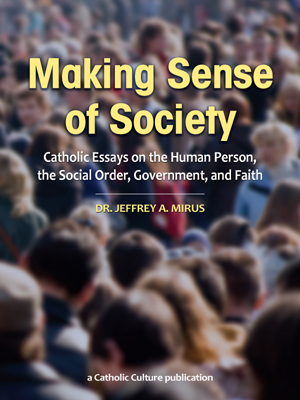Debunking the debunkers: how the best scholarly evidence confirms the Gospels
By Phil Lawler ( bio - articles - email ) | Mar 18, 2016 | In Reviews
Any day now, a major media outlet will release a feature story which, with a great deal of promotional ballyhoo, will claim to call into question the ordinary Christian understanding of the Gospel story. It’s become an annual tradition: as Easter approaches, and secular journalists look for an exciting new angle, an enterprising scholar offers his own latest theory to debunk the faith.
The nature of the scholarly theory differs from year to year. It may be the reported discovery of a new gospel, or of a grave that is said to contain the remains of Jesus. Or it may simply be a new interpretation of familiar Bible verses. Sometimes the theory comes from the “Jesus Seminar,” a cabal of academics committed to reinterpreting the Gospels. Sometimes the stories can be traced to theorists with no real academic background: intellectual loners with their own pet projects.
The skeptics’ theories usually make a splash, and the headline stories are copied from one media outlet to another. But they never withstand serious scrutiny. Reporters who have no real understanding of Christian belief are easily satisfied; if the story commands attention for a few days, that’s good enough. But serious scholars—to say nothing of serious believers—soon recognize the holes on the skeptics’ arguments.
In Searching for Jesus, Robert Hutchinson has provided a resource that could help reporters avoid falling prey to the annual fad. Hutchinson is a journalist rather than an academic—although he has read deeply into the issues of Bible research and traveled the world to see the sites of Gospel stories and to interview the leading scholars—and he offers a very readable introduction to the field of Bible criticism.
One very fundamental problem with the skeptics’ approach, Hutchinson points out, is that they start with a presumption that the common Christian interpretation of the Bible is defective: that belief in the Resurrection, or the miracles, or the authority of the Church are based on misunderstandings of what Jesus actually said and did—that “when in doubt, the early Church must have made it all up.” Yet the skeptics feel free to draw out their own interpretations of the Bible stories. If the evidence to prove the orthodox Christian interpretation is incomplete, the evidence to prove the skeptics’ theories is non-existent.
This is particularly true of the “Gnostic gospels”—a collection of writings of uncertain authenticity, mostly written long after the canonical Gospels, often by authors who had already broken from the mainstream of early Christian thought. Scholars who rely on these texts to discern the “real” teachings of Jesus are selectively choosing their own favorite themes, Hutchinson observes. “This means that study of the Gnostic texts teaches us a lot about Gnosticism but very little new about Jesus or his message.”
It is true that, as skeptical scholars say, that apart from the oral traditions of Church teaching, there is very little evidence outside the Bible itself to prove the accuracy of the Gospel accounts. But then that argument cuts both ways; there is also little or no evidence that would contradict the Gospel accounts. As a result Albert Schweitzer—himself a skeptic of sorts-- remarked that would-be interpreters tend to bring their own prejudices to bear, accepting the Gospel where they find it congenial and doubting what they find tougher to accept.
But the lack of external evidence from 2,000 years ago should not by itself prompt skepticism, Hutchinson reasons. He notes that we have many more early manuscripts of the Gospels than of Plato’s works, yet few people question the authenticity of the dialogues.
Moreover, Hutchinson shows that in case after case, when serious scholars dig into the evidence that is available, they find that support for the orthodox Christian understanding of the Gospel message. The latest archeological discoveries in the Holy Land, the best new translations, the most exhaustive textual analyses all point in the same direction.
Along with the scholarly evidence, Hutchinson includes some powerful logical arguments to debunk the would-be debunkers. For example:
- If Jesus was just a radical political activist, why did the Romans—who were ruthless in stamping out opposition—arrest none of his followers?
- If belief in the Resurrection of Jesus was a myth, similar to myths of resurrection of other religious leaders of that time, what happened to all those others? Why did faith in Christ’s Resurrection thrive, long after all the others were forgotten?
- Similarly, if the Gnostics represented the “real” teachings of Jesus, while the institutional Church was more interested in politics, why did the Church survive and the Gnostics disappear?
With his background as a free-lance journalist, Hutchinson also has a realist’s grasp of how stories can be sold. He recognizes the appeal of the debunking stories, and he sees how researchers can take advantage of publicity to advance their theories. The temptation is especially strong for those who need financial support for their work, he observes. “Because cash-strapped archeologists now depend upon funding from such groups as the National Geographic Society and the Discovery Channel, they are under increasing pressure to announce ever-more-sensational “discoveries” to justify their big budgets.”
So this year, when the “discovery” comes, don’t be alarmed. Hutchinson’s work sustains the believer’s confidence that this too will pass.
Which is not to say that Searching for Jesus is a normal work of Christian apologetics. Hutchinson includes bits of travelogue and personal reflections along with his analysis. More to the point, he does not set out explicitly to defend the faith, and in fact he closes with the rather deflating conclusion that Jesus is a unique and compelling figure, rather than a ringing endorsement that He is the Savior, the Messiah, the Incarnate God.
Hutchinson’s approach to the Gospels, too, will leave some Christians unsatisfied. Apparently determined to reach those readers who do not know what to make of the arguments, he adopts the same neutral attitude as that of the champions of the historical-critical approach. He is willing to explore all the claims of the skeptics dispassionately, including even the claims that believing Christians will find repugnant or even blasphemous.
This neutral perspective may be valuable in reaching curious readers who are ready to accept persuasive arguments for the authenticity of the Gospels and the truth of Christ’s teachings. But Hutchinson’s unusual approach could be disconcerting to Christians who already accept the teachings of the Church, and realize that the Gospel, to be understood properly, must be read through the eyes of faith.
All comments are moderated. To lighten our editing burden, only current donors are allowed to Sound Off. If you are a current donor, log in to see the comment form; otherwise please support our work, and Sound Off!
-
Posted by: AgnesDay -
Apr. 20, 2016 5:21 PM ET USA
I had just come out of a series of special education planning meetings, headed for lunch, and heard the news on NPR, the only station I could receive in that part of south Arkansas. They were nonplussed that Papa Benedetto had been elected: I almost ran off the road in my excitement, and I forgot where I agreed to meet my colleagues for lunch.
-
Posted by: james-w-anderson8230 -
Mar. 22, 2016 10:57 PM ET USA
Thanks for the recommendation. I can't wait for it to arrive.








